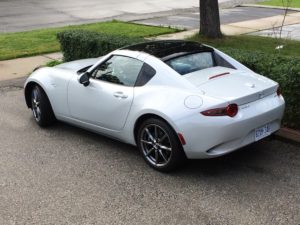Diminutive sports cars stand the test of time. From the old-time barchetta (pronounced “bar-KETT-a”) to the Japanese hatchbacks of the late 70s and early 80s to the “spiders” from various manufacturers, that mix of just the right amount of power and driving dynamics in a tight package still turns heads and leaves drivers smiling once they leave the cockpit.
Today’s incarnation of the Mazda Miata continues to enthrall buyers. Several years ago, Mazda updated the package with SKYACTIV technologies and the KODO Soul of Motion. Now, Mazda offers a retractable fastback roof and calls it the Mazda MX-5 RF.

image courtesy Jim Cloughley
First impressions
The MX-5 has always been a tiny car. That’s arguably part of its charm, as well as attractiveness to race enthusiasts. But its size kept “outsized” sports car enthusiasts like yours truly out of the drivers seat – until two years ago. The soft-top MX-5 finally fits my 6’5″ frame. With the roof up, the RF forces me to bend my head forward a little. Fortunately, I didn’t need to keep the roof up much during my week with the RF GT.
The MX-5 has also always been an attractive car, and this iteration ups the looks ante. The Ceramic Metallic paint confounded several people’s attempts to name the colour. What nobody missed was the way the colour highlighted Mazda’s KODO Soul of Motion design. Lines swoop and dive all over the car, making it look quick even standing still.

The power-retractable piano-black hardtop, (which makes this MX-5 a retractable fastback, or RF) hearkens back to 80’s-era two-seater-speedsters from Japan, with rooflines that swoop down and inward to abbreviated trunk lids. Keeping the fastback look with the top “down” ensures this car keeps that sexy appearance no matter the configuration.
It’s fun to watch the roof move, too. The three sections and rear window move in concert, folding down or setting up quickly. The rear section pops up to make room for the other two sections to fold themselves away or come back into position.
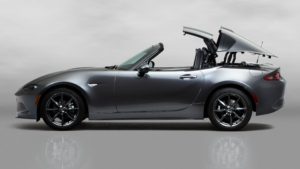
image courtesy Mazda
Toronto sports fans might liken the experience to the first time they saw the roof of the Rogers Centre open or close. Owners may find themselves being asked to demonstrate the movement. Check out my amateurish narration of the Mazda MX-5 RF (which I called the Mazda RF here) movement here. (Video and extra commentary: Jim Cloughley.)
Interior
One last note on the roof: the driver, who has to be in the vehicle to operate the roof, can watch the progress on the 4.6” multi-information display, the leftmost of three parts in the instrument cluster. Kudos to Mazda for making the tachometer the biggest dial here and sticking it in the cluster’s centre. (Why do race cars not have speedometers? If you aren’t in first place, you aren’t going fast enough.)
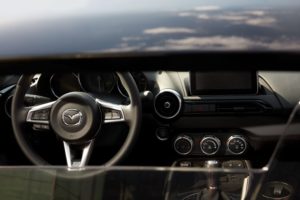
image courtesy Mazda
As to the rest of the interior, low is the first word that comes to mind. Cramped is the second. That’s both good and bad. This interior creates that low-slung, tight racing-type cockpit sure to warm the hearts of driving enthusiasts.
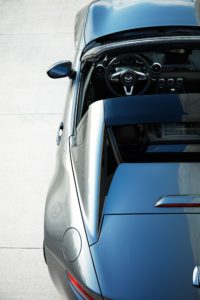
image courtesy Mazda
But there are some practical tradeoffs. It’s rare to drive a vehicle with no glovebox ahead of the front passenger seat. That glovebox resides between the seat backs at shoulder level. The optical disc “slot” resides just below the glovebox. Discs slide out just above the moveable cupholders, which sit in cleverly designed slots. (One cupholder also clips in just right of the centre stack by the passenger’s left knee.) Just ahead of the cupholders is a tiny cubby unfit for today’s monster-sized phones, a.k.a. “phablets” (is that word still in vogue, or have we accepted the reversal to bigger and bigger phones?) There’s a storage compartment behind the passenger seat. (The softtop MX-5 has another such compartment behind the driver’s seat as well.)
To drive this point home: I needed to put my jacket in the trunk when I picked up a passenger for a spin in the RF.
Mazda offsets the lack of space with a beautiful interior. My tester’s Ceramic Metallic paint job creeps inside the cabin, over the tops of the doors, where it gives way to lovely red stitched leather that also covers the heated seats. A stitched leather steering wheel, shift knob and brake lever all feel great to the touch.
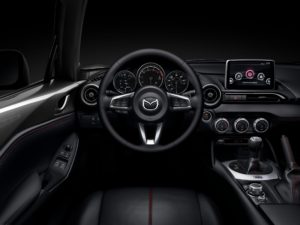
image courtesy Mazda
While in motion with the top down, air escapes through a deflector that protects occupants from the worst of wind buffeting.
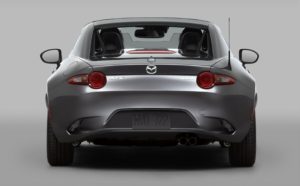
image courtesy Mazda
Hockey bag test
Fail. After all, when the RF folds itself down for open-air driving, it needs room to store its parts. Mazda claims the trunk is the same size as the one in the soft top MX-5. The bag rode up front, as did the sticks. Needless to say, I rode to the rink with the top down.

A friend took a look at the trunk and told me his golf bag wouldn’t fit in it. That said, it did carry a couple of overnight bags, plenty of groceries, a zucchini lasagna and various other things.
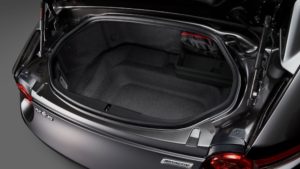
image courtesy Mazda
Did I mention that the trunk also holds the manuals?
In-cabin electronics
You’ll find most of the modern conveniences inside the MX-5, but it still feels technologically sparse – in a good way.
Mazda offers its 7” colour touchscreen interface, complete with quick-to-learn HMI Commander knob/button/joystick sitting just behind the gearshift. (My forearm sometimes tapped the button when I reached back after making a gearshift.) Mazda provides two USB ports in this two-seater, as well as the requisite steering wheel controls and instrument cluster screen.
Otherwise, no extraneous screens reside in the MX-5. Climate controls consist of three dials. No heads-up display flipped up when I hit the start/stop button.
The MX-5 hits all required technology bases, but I doubt drivers buy it for the gadgets.
Driving
The drive is why you buy an MX-5. (Well, the driving experience AND the looks.) The long hood conceals a SKYACTIV-G 2.0L Inline 4 that generates 155 hp and 148 lb-ft of torque that puts that power to the rear wheels.
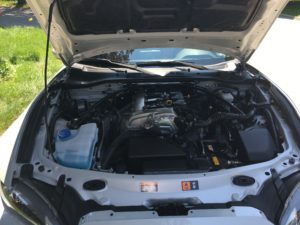
image: Jim Cloughley
This might seem like a paltry amount of power. But this light, wheels-at-the-corners car handles corners beautifully and still enables quick starts. You can also drive for good fuel economy, though fuel economy might not be the first thing on your mind when you’re behind the wheel.
You will feel the bumps more than you would in an average car, thanks to the sport suspension with Bilstein shocks.
I controlled the flow of power using the smooth-shifting SKYACTIV-MT 6-speed manual transmission.
Active safety features include traction control, dynamic stability control, blind spot warnings and lane departure warnings.
Visibility when reversing is reasonably good. The low stance means you see more of what’s behind you, and the fastback doesn’t obstruct too much of your view. This is great, since the RF is the first new car I’ve tested in a while in which a rear-view camera does not take over the in-cabin screen when you select reverse gear.
Fuel economy
Even with the top down all the time, I managed under 7 L/100km. (Mazda quotes 8.9 in the city and 7.1 on the highway.) This is part of the virtue of not shoehorning an overpowered engine into the MX-5. I could only imagine how little fuel this car sips if you drive it in aerodynamic (i.e. top up) form.
The RF takes premium unleaded in its 45L tank.
Pricing
Mazda offers the MX-5 RF GT at an MSRP of $42,200. As tested, with options and other charges, the RF I drove came to $45,095.
